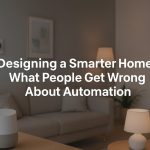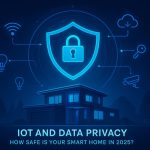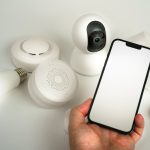In a world where convenience often comes at the cost of privacy, many smart home owners are beginning to ask: Do I really need the cloud to run my smart devices? The answer is: no, you don’t. In fact, building a private smart home network is not only possible — it’s more secure, faster, and gives you total control over your data.
This guide will walk you through everything you need to know to set up a cloud-free smart home network — from the essential hardware and software, to device compatibility, and security tips.
Why Avoid the Cloud in Smart Homes?
Using the cloud in smart homes means your data — video, voice commands, schedules — is sent to and stored on external servers. This raises concerns about:
- Privacy – Cloud services collect data that can be used for advertising or worse.
- Downtime – Internet issues can render your smart devices useless.
- Control – You’re dependent on third-party companies for device functionality.
- Security – Cloud services are prime targets for hacking.
A local smart home avoids these issues by running everything on your home network, offline, with optional remote access you control.
Benefits of a Local Smart Home Network
- ✅ 100% control over data and automations
- ✅ Faster response times — no lag from cloud round-trips
- ✅ Works even if the internet is down
- ✅ Highly customizable
- ✅ Scalable and future-proof
What You’ll Need
To build your private smart home network, you’ll need:
1. A Smart Home Hub
A smart hub acts as the brain of your system. You can use:
- Home Assistant (recommended) – Open-source, powerful, runs locally.
- OpenHAB – Java-based, good for technical users.
- Domoticz – Lightweight and beginner-friendly.
All three options support local control and work without any external servers.
2. A Raspberry Pi or Mini PC
This will run your home automation hub software:
- Raspberry Pi 4 (with SD card and power supply)
- Intel NUC or similar mini PC (for heavier setups)
- NAS with Docker support (e.g., Synology)
3. Compatible Smart Devices
Choose devices that support local control protocols like:
- Zigbee or Z-Wave (for lights, switches, sensors)
- Wi-Fi with local API (e.g., Shelly, Tasmota, ESPHome)
🔧 Pro tip: Avoid devices that only work with Alexa, Google, or proprietary apps.
4. Local Voice Assistant (Optional)
You can integrate voice control without cloud:
- Rhasspy or Mycroft (run on Raspberry Pi)
- Offline speech recognition tools integrated into Home Assistant
Setting Up: Step-by-Step
Step 1: Install Home Assistant
- Flash Home Assistant OS to an SD card using [balenaEtcher].
- Boot the Raspberry Pi and connect it to Ethernet or Wi-Fi.
- Access Home Assistant via browser:
http://homeassistant.local:8123 - Follow the onboarding wizard.
Step 2: Set Up Devices
- Pair Zigbee devices using a USB stick like Sonoff Zigbee 3.0 or ConBee II.
- Add Wi-Fi devices with local firmware (Tasmota, ESPHome).
- Organize devices by room or function.
Step 3: Create Automations
Examples:
- “Turn on hallway light when motion detected after sunset.”
- “Send a local push notification when the front door opens.”
No cloud needed — all logic runs inside your home.
Step 4: Secure the Network
- Change default passwords on your devices.
- Use VLANs or separate Wi-Fi SSIDs for smart devices.
- Disable internet access for cloud-only devices.
- Back up your configuration regularly.
Step 5: Optional Remote Access
- Use WireGuard VPN for encrypted remote access.
- Or Nabu Casa for privacy-friendly remote control (paid, but doesn’t store data).
Diagram: Local Smart Home Setup
[ Internet ] <== optional remote VPN access
|
[ Router ]
|
[ Raspberry Pi / Home Assistant Hub ]
|
[ Zigbee/Z-Wave Devices ] [ Local Wi-Fi Devices ]
|
[ Voice Assistant / Local Control ]
Troubleshooting Tips
- If a device disappears, check power and network connection.
- Use Home Assistant logs for automation errors.
- Keep firmware updated — but avoid updates that add cloud dependence!
Final Thoughts
By building a cloud-free smart home, you’re stepping into a world of smarter automation, complete privacy, and tech independence. It may require a bit of effort to set up, but the rewards in speed, reliability, and data ownership are well worth it.
With the right hardware, software, and mindset, you can own your smart home — not just rent it from a big tech company.
FAQ: Smart Home Network Without the Cloud
Q: Is a local smart home network harder to maintain than a cloud one?
A: Initially, yes — there’s a learning curve. But once set up, local systems are far more stable and customizable.
Q: Can I still control my devices remotely?
A: Yes, through a VPN or Nabu Casa integration, you can securely access your system from anywhere.
Q: What happens when the internet goes down?
A: Your smart home will continue working normally, as all automations and controls are local.
Q: Do I need to know how to code?
A: Not necessarily. Tools like Home Assistant have friendly UIs and community support. Some YAML knowledge helps, but isn’t required.
Q: Is it cheaper to go cloud-free?
A: Over time, yes. You avoid monthly fees and can choose open-source or DIY hardware that’s often less expensive.
- Designing a Smarter Home in 2026: What People Get Wrong About Automation
 Smart homes were once science fiction, but today they’re a reality in millions of households. With voice assistants, smart plugs, and automated lighting systems, it’s easy to assume home automation is simply a matter of plugging in a few devices. Yet, many homeowners quickly discover that “smart” doesn’t always mean simple. In this article, we’ll…
Smart homes were once science fiction, but today they’re a reality in millions of households. With voice assistants, smart plugs, and automated lighting systems, it’s easy to assume home automation is simply a matter of plugging in a few devices. Yet, many homeowners quickly discover that “smart” doesn’t always mean simple. In this article, we’ll… - Automated Online Trading: How IoT is Redefining Financial Markets
 Introduction automated online trading In a world where milliseconds can decide millions, the fusion of Internet of Things (IoT) technology and automated online trading is reshaping global finance. What once relied solely on human judgment now increasingly depends on connected machines, real-time data, and predictive algorithms. From weather sensors influencing agricultural trades to smart logistics…
Introduction automated online trading In a world where milliseconds can decide millions, the fusion of Internet of Things (IoT) technology and automated online trading is reshaping global finance. What once relied solely on human judgment now increasingly depends on connected machines, real-time data, and predictive algorithms. From weather sensors influencing agricultural trades to smart logistics… - The Role of Linux in IoT: Powering the Connected World
 The Internet of Things (IoT) is everywhere—from smart homes and wearable devices to industrial automation and self-driving cars. Behind the scenes, one operating system plays a surprisingly dominant role: Linux. Known for its stability, flexibility, and open-source nature, Linux has become the backbone of countless IoT devices and platforms. But what makes Linux so well-suited…
The Internet of Things (IoT) is everywhere—from smart homes and wearable devices to industrial automation and self-driving cars. Behind the scenes, one operating system plays a surprisingly dominant role: Linux. Known for its stability, flexibility, and open-source nature, Linux has become the backbone of countless IoT devices and platforms. But what makes Linux so well-suited… - The Smart Home Revolution in 2025: How IoT is Transforming Everyday Living
 In the past decade, the vision of a truly smart home has moved from futuristic fantasy to everyday reality. As we step into 2025, the Internet of Things (IoT) has matured into a robust ecosystem, connecting appliances, security systems, lighting, and even entertainment devices under one seamless digital roof. The result? Homes that are safer,…
In the past decade, the vision of a truly smart home has moved from futuristic fantasy to everyday reality. As we step into 2025, the Internet of Things (IoT) has matured into a robust ecosystem, connecting appliances, security systems, lighting, and even entertainment devices under one seamless digital roof. The result? Homes that are safer,… - IoT and Data Privacy: How Safe Is Your Smart Home in 2025? – IoT Security
 The smart home revolution has made everyday life more convenient than ever. From voice assistants that control the lights to security cameras that send alerts directly to your phone, connected devices have become part of our daily routines. But with this convenience comes an important question: how safe is your personal data in a world…
The smart home revolution has made everyday life more convenient than ever. From voice assistants that control the lights to security cameras that send alerts directly to your phone, connected devices have become part of our daily routines. But with this convenience comes an important question: how safe is your personal data in a world…









